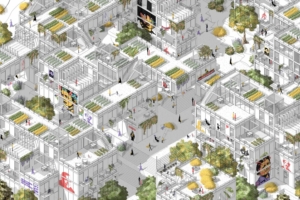This website uses cookies so that we can provide you with the best user experience possible. Cookie information is stored in your browser and performs functions such as recognising you when you return to our website and helping our team to understand which sections of the website you find most interesting and useful.
Interview with Sergio Mutis, LICC Winner in BUILD (Architecture) in the Non-Professional category. He shares that his Colombian roots play a crucial role in his artwork such as the colorful, and vibrant streets of El Curubo.
Why did you choose to pursue a career as an architect?
I choose to pursue a career in the same way that most senior high school students do: out of utter ignorance. Yet, beyond the restless nights and pretentious jargon, it has proven to be a beautiful and surprisingly rewarding career.
How did the idea behind your winning project come about?
During my undergraduate studies, I had the opportunity to volunteer, design, and share with vulnerable communities in marginal Bogota. Doing so, I learned that the housing deficiency of my country was much more than a simplistic capital to square-meter equation. To me, the so-called “informal” neighborhoods, with their heterogeneous and captivating spatiality, were categorically better at responding to the complex and dynamic reality of their inhabitants than the “formal” housing industry, with its site-oblivious and homogeneous repetition. And so, the seeds this project came about, as ironically simple as they are: First, approach the design taking into account the true complexity of the problem. Second, learn from the people that face it every day (they probably know much more than you about it).
What impact does your background have on your work?

Best in BUILD (Non-Professional): “HAMBO. Bolonia’s Multidimensional Habitation: Systematic Design Resilience for Social Justice.” by Sergio Mutis
I am currently living in London, yet, being born and raised in Colombia, my country is ever-present in mind and my work. And, with ‘country’, I do not mean the nation. I mean my first sight of the fascinatingly intricate, colorful, and vibrant streets of El Curubo self-built informal settlement, accompanied by Don Enersto’s confusion about the overtly diverse façade styles of all of his immigrant neighbors’ houses. I mean the sensation of the sand in-between my toes underneath the spacious palm-tree maloca where my father used to throw parranda vallenata celebrations with aguardiente shots, and where the walls aligned to reveal the backdrop of the sunset behind the Caribbean Sea and the snow-capped Sierra Nevada mountain. I mean the sound of my aunt Clarita’s raspy gypsy voice singing about her bohemian nights in Cartagena, while I ate hormigas culonas under the rustic wooden roof of her casona beneath the starry sky of Chicamocha Canyon. I mean the long sentences filled with meaning that we all read on Gabo’s Cien Años de Soledad, and that are so uncommon and disliked in English-speaking countries. I mean the architecture, the land, the culture, the people, but, most of all, the details. And so, even when I try to author a simple design, I will always find myself attempting to harmonize a plethora of diverse arguments, strategies, and details that, unequivocally, shape my architecture.
How do you envision the future of your industry? What do you see as the most significant difficulties and opportunities?
Architecture has had a hard time catching up to the technological juncture of the time. The modernist architect’s wildest dreams of prefabricated utopias of steel and glass could be put to shame by the technology of washing machines and airplanes. Currently, architecture does not seem to reflect the full potential of the digital revolution, but this might change. I believe that a significant difficulty and opportunity for the future of architecture is to make the most of its technological juncture. Collaborative human-AI design, for instance, might prove crucial to overcome some of our inherent human limitations and contribute to society in a categorically different level. Yet, this probably is the naïve perspective of a young architect who is still in school.
How does it make you feel to win this award?
Profoundly humbled and thankful, particularly towards the Bolonian community. HAMBO was defined by their participatory design and it is dedicated to their welcoming and inspiring friendship. Hopefully, in their honor, the project can contribute to raise awareness of the importance of socially-driven design worldwide.
© 2024 London International Creative Competition




Recent Comments